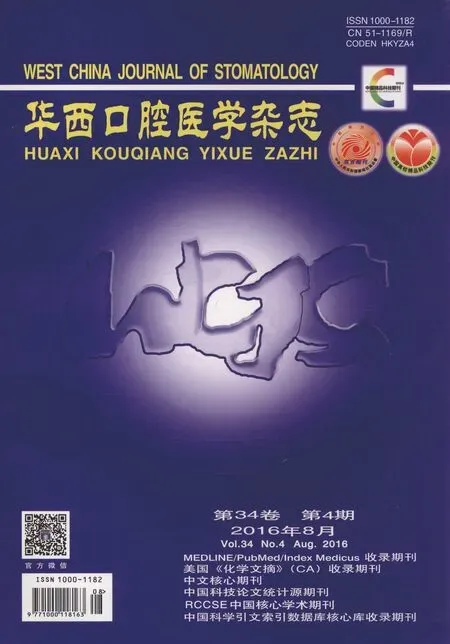牙龈卟啉单胞菌对兔血管内皮组织中白细胞介素-33表达的影响
李维善 李德超 邱蓉蓉
佳木斯大学附属口腔医院牙周黏膜病科,佳木斯 154007
牙龈卟啉单胞菌对兔血管内皮组织中白细胞介素-33表达的影响
李维善李德超邱蓉蓉
佳木斯大学附属口腔医院牙周黏膜病科,佳木斯 154007
目的用牙龈卟啉单胞菌感染兔建立动脉粥样硬化(AS)模型,观察感染兔主动脉血管内皮细胞中白细胞介素-33(IL-33)的变化,探讨牙龈卟啉单胞菌与AS的关系。方法将24只新西兰大白兔分为对照组和实验组。实验组每周1次静脉注射牙龈卟啉单胞菌培养液,持续12周,建立感染兔AS模型;对照组每周1次注射等量生理盐水。实验13周处死实验动物,观察主动脉血管的组织结构;通过免疫组织化学染色、实时荧光半定量聚合酶链式反应和Western blot法检测兔主动脉血管内皮细胞中IL-33 mRNA和蛋白质的表达。结果实验组血管内皮细胞IL-33 mRNA相对表达量为58.244±2.407,IL-33蛋白相对表达量为1.863±0.171,对照组IL-33 mRNA相对表达量为3.143±0.805,IL-33蛋白相对表达量为0.537±0.028;实验组IL-33的mRNA和蛋白的表达量均明显高于对照组(P<0.01)。结论牙龈卟啉单胞菌感染能促进血管内皮细胞表达IL-33,可能对AS的发生发展有一定的调节作用。
牙龈卟啉单胞菌;血管内皮组织;白细胞介素-33;动脉粥样硬化
牙龈卟啉单胞菌是慢性牙周炎的主要致病菌。动脉粥样硬化(atherosclerosis,AS)是心血管疾病中最常见的一种炎症性疾病,严重威胁人类健康。已有研究[1]表明,微生物感染在AS发病中起重要作用。炎症学说已成为AS的研究热点。已有研究[2]发现,牙周炎和AS间存在相关性,炎症因子可能是两者相关性的桥梁和纽带。白细胞介素-33(interleukin-33,IL-33)在炎症、感染、自身免疫性疾病中发挥重要的作用,与AS的发生发展也关系密切[3]。IL-33 是AS的保护因子,其含量变化可提示AS的严重程度。目前牙龈卟啉单胞菌对IL-33表达影响的研究还比较少见。本研究通过牙龈卟啉单胞菌感染AS动物模型来观察血管内皮细胞中IL-33的表达,以探讨牙龈卟啉单胞菌在AS中的作用。
1 材料和方法
1.1细菌的培养与鉴定
牙龈卟啉单胞菌标准菌株ATCC33277(广东省微生物菌种保藏中心提供)复苏后接种于哥伦比亚血平板上,厌氧罐内37 ℃培养3~5 d,革兰染色后镜检,油镜下可见革兰染色阴性的红色杆状菌体。于脑心浸液肉汤(brain heart infusion broth,BHI)液体培养基中培养增菌,用麦氏比浊法将鉴定后的菌液配制成密度为1×107CFU·mL-1。
1.2实验分组
选择24只新西兰大白兔(佳木斯大学实验动物中心提供)作为实验动物,体重为2.0~2.5 kg,随机分为两组。实验组18只,静脉注射100 μL密度为1× 107CFU·mL-1牙龈卟啉单胞菌培养液,每周1次,持续12周,建立牙龈卟啉单胞菌感染的AS模型[4];对照组6只,每周1次静脉注射100 μL生理盐水。13周后处死所有动物,取兔主动脉,部分用10%甲醛溶液固定,用于组织病理学和免疫组织化学实验,余下部分使用液氮保存,用于基因和蛋白质表达情况的检测。
1.3主动脉的病理组织学观察
主动脉标本切片采用苏木精-伊红(hematoxylineosin,HE)常规染色,制成病理组织切片,显微镜下观察。
1.4IL-33表达的检测
1.4.1主动脉血管内皮中IL-33的分布采用免疫组织化学染色法观察主动脉血管内皮中IL-33的分布。血管组织经修整后,脱水、透明、浸蜡和包埋,采用免疫组织化学法进行染色。标本切片,室温下孵育5~10 min,滴加一抗和二抗(Santa Cruz公司,美国),显色,复染,中性树胶封片,置于Motic3000显微摄影系统下于400倍下摄片,观察IL-33染色情况,以细胞质内出现棕黄色颗粒,且着色强度高于背景非特异性染色者判定为阳性。采用Image-pro plus 6.0病理图像分析系统对IL-33阳性表达进行半定量分析,以积分光密度(integral optical density,IOD)代表IL-33蛋白的相对表达量。IOD测量方法为阳性面积×平均光密度。每组随机分析6个高倍视野,取其均值代表该组IL-33的相对表达量。
1.4.2主动脉血管内皮中IL-33 mRNA的表达每组各选取5个样本,采用实时荧光半定量聚合酶链式反应法检测IL-33 mRNA的表达[5],每个样品重复3次,采用FR-2000型图像分析系统进行光密度扫描,光密度测量结果代表mRNA的相对表达量,取平均值进行统计学分析。实验所用引物序列如下:上游引物,5'-CCAGAATAGTGAGAGTGGGGAA-3';下游引物,5'-CGCATGTAGTAAGGTGGGAACC-3';产物长度为110 bp。
1.4.3IL-33蛋白的表达量采用Western blot法检测IL-33蛋白的表达量[6]。对照组和实验组各取3只兔的主动脉,用蛋白裂解液提取蛋白,用BCA试剂盒检测蛋白浓度,以甘油醛-3-磷酸脱氢酶(glyceraldehyde-3-phosphate dehydrogenase,GAPDH )为内参。每个样品取20 μg蛋白质上样,进行十二烷基硫酸钠聚丙烯酰胺凝胶电泳(sodium dodecyl sulfate-polyacrylamide gel electrophoresis,SDS-PAGE)。冰上90 V电压下转膜90 min,BSA封闭,置摇床上1 h,孵育一抗,4 ℃过夜,次日TBST洗3次,室温下孵育二抗1 h,化学发光、显影、定影,用凝胶图形分析。
1.5统计学分析
采用SPSS 18.0软件进行单因素方差分析,比较实验组与对照组的差异。检验水准为双侧α=0.05。
2 结果
2.1兔主动脉组织学观察
对照组主动脉血管平整、致密,内膜完整,弹力纤维和平滑肌纤维规整;实验组可见内膜层有不程度增厚,并向管腔内轻度凸出,形成斑块,内膜主要为泡沫细胞(图1);该结果证实AS动物模型建模成功。
2.2免疫组织化学染色
IL-33的免疫组织化学染色结果见图2:IL-33的阳性表达主要集中于细胞质内,呈棕黄色。实验组IOD值为2 253.848±195.689,对照组为1 803.587± 184.653,二者差异有统计学意义(P<0.01),实验组相对表达量高于对照组。

图1 血管内皮细胞的组织学观察 HE × 200Fig 1 Histological observation of vascular endothelial cells HE × 200

图2 IL-33的表达 免疫组织化学染色 × 200Fig 2 The expressions of IL-33 immunohistochemistry × 200
2.3IL-33 mRNA的表达
实验组IL-33的mRNA相对表达量为58.244± 2.407,对照组为3.143±0.805,实验组明显高于对照组,两组差异有统计学意义(P<0.01)。
2.4IL-33蛋白的表达
IL-33蛋白表达的Western blot检测结果见图3,实验组相对表达量为1.863±0.171,对照组为0.537± 0.028,两组间差异有统计学意义,实验组明显高于对照组(P<0.01)。

图3 IL-33的Western blot检测Fig 3 Western blot analysis of IL-33
3 讨论
牙龈卟啉单胞菌是目前公认的慢性牙周炎的主要致病菌,其慢性感染可影响血管内皮细胞的完整性,脂蛋白代谢,凝血以及血小板功能等[7],损伤牙周组织和局部血管生理功能。研究[8]发现,牙龈卟啉单胞菌感染可诱导猪冠状动脉和主动脉AS的形成,为其建立动物模型提供了佐证。
目前认为,AS是炎症性疾病[9],是血管内膜损伤导致脂质沉积和纤维组织增生的过程,是一种大中动脉的慢性炎症反应[10],其发生发展始终伴随着炎症反应,长期感染亦是炎症性心血管疾病的危险因素[11]。牙周炎是微生物感染引起的慢性感染性疾病,可引起龈沟液等局部组织的炎症细胞因子水平升高,而高水平的炎症细胞因子与AS形成密切相关。Li等[12]发现,小鼠经静脉注射牙龈卟啉单胞菌后AS病变范围扩大。Lalla等[13]发现,小鼠局部感染牙龈卟啉单胞菌后,AS斑块数目增加,AS的病变范围也增加了40%,且在主动脉检测出牙龈卟啉单胞菌DNA的存在。Jain等[14]建立AS模型,用丝线结扎磨牙并接种牙龈卟啉单胞菌诱发牙周炎,结果发现,在发生牙周炎的兔动脉壁上脂质沉积增加,说明牙龈卟啉单胞菌是AS的潜在危险因素。
IL-33是白细胞介素-1家族的一员,在许多免疫疾病中有多向效应,对炎症有双向调控作用[15]。在自身免疫性疾病和变态反应性疾病中有促炎作用,而对多种心血管疾病有保护作用。IL-33主要表达在成纤维细胞、上皮细胞和内皮细胞中。IL-33在内皮细胞的细胞核中积聚,具有促使血管内皮的免疫反应辅助性T细胞(helper T cell,Th)1向Th2转化的作用,由此发挥保护血管内皮的功能。AS的炎症反应主要由Th1细胞分化及其激活的炎症细胞因子驱动,Th1细胞有促进AS斑块失稳定作用[16],而Th2介导的反应可抑制AS斑块的形成和促进已形成斑块的溶解,IL-33可诱导Th1细胞向Th2细胞分化,减少Th1相关因子分泌,增加Th2因子的分泌[17],因此IL-33可能在AS发展中起保护作用。IL-33的表达水平可提示AS的严重程度。本实验结果显示,牙龈卟啉单胞菌感染后致使AS模型的血管内皮细胞内IL-33的分布、基因和蛋白表达均增加,提示牙龈卟啉单胞菌在AS发展过程中有促进作用,其具体机制有待进一步深入研究。
[1] Persson GR, Persson RE. Cardiovascular disease and periodontitis: an update on the associations and risk[J]. J Clin Periodontol, 2008, 35(8 Suppl):362-379.
[2] Lockhart PB, Bolger AF, Papapanou PN, et al. Periodontaldisease and atherosclerotic vascular disease: does the evidence support an independent association? a scientific statement from the American Heart Association[J]. Circulation,2012, 125(20):2520-2544.
[3] Foks AC, Lichtman AH, Kuiper J. Treating atherosclerosis with regulatory T cells[J]. Arterioscler Thromb Vasc Biol,2015, 35(2):280-287.
[4] 张明珠, 梁景平, 李超伦, 等. 牙龈卟啉单胞菌感染兔动脉粥样硬化模型的建立[J]. 上海交通大学学报(医学版),2007, 27(6):642-645. Zhang MZ, Liang JP, Li CL, et al. Establishment of rabbit atherosclerotic model with Porphyromonas gingivalis infection[J]. J Shanghai Jiaotong Univ (Med Sci), 2007, 27 (6):642-645.
[5] 陈伟, 刘艳, 杨紧根, 等. 实时定量PCR技术检测结核分枝杆菌蛋白编码基因表达水平研究[J]. 中国病原生物学杂志, 2012, 7(4):254-257. Chen W, Liu Y, Yang JG, et al. Level of expression of the genes coding for proteins in Mycobacterium tuberculosis according to qRT-PCR[J]. Chin J Pathog Biol, 2012, 7(4): 254-257.
[6] 魏魁杰, 张雷, 杨筱, 等. 细胞角蛋白17在口腔鳞癌中的表达[J]. 华西口腔医学杂志, 2011, 29(4):404-408. Wei KJ, Zhang L, Yang X, et al. Expression of cytokeratin 17 in oral squamous cell carcinoma[J]. West Chin J Stomatol,2011, 29(4):404-408.
[7] Han YW, Wang X. Mobile microbiome: oral bacteria in extra-oral infections and inflammation[J]. J Dent Res, 2013,92(6):485-491.
[8] Brodala N, Merricks EP, Bellinger DA, et al. Porphyromonas gingivalis bacteremia induces coronary and aortic atherosclerosis in normocholesterolemic and hypercholesterolemic pigs[J]. Arterioscler Thromb Vasc Biol, 2005, 25(7):1446-1451.
[9] Libby P, Ridker PM, Hansson GK. Progress and challenges in translating the biology of atherosclerosis[J]. Nature, 2011,473(7347):317-325.
[10] Matheeussen V, Waumans Y, Martinet W, et al. Dipeptidyl peptidases in atherosclerosis: expression and role in macrophage differentiation, activation and apoptosis[J]. Basic Res Cardiol, 2013, 108(3):350.
[11] 屠彦, 陈晖. 口腔感染引发心血管疾病的机制[J]. 国际口腔医学杂志, 2010, 37(2):182-185. Tu Y, Chen H. Mechanism of cardiovascular disease caused by oral infection[J]. Int J Stomatol, 2010, 37(2):182-185.
[12] Li L, Messas E, Batista EL Jr, et al. Porphyromonas gingivalis infection accelerates the progression of atherosclerosis in a heterozygous apolipoprotein E-deficient murine model [J]. Circulation, 2002, 105(7):861-867.
[13] Lalla E, Lamster IB, Hofmann MA, et al. Oral infection with a periodontal pathogen accelerates early atherosclerosis in apolipoprotein E-null mice[J]. Arterioscler Thromb Vasc Biol, 2003, 23(8):1405-1411.
[14] Jain A, Batista EL Jr, Serhan C, et al. Role for periodontitis in the progression of lipid deposition in an animal model[J]. Infect Immun, 2003, 71(10):6012-6018.
[15] Pei C, Barbour M, Fairlie-Clarke KJ, et al. Emerging role of interleukin-33 in autoimmune diseases[J]. Immunology,2014, 141(1):9-17.
[16] Pylaeva EA, Potekhina AV, Provatorov SI, et al. Effector and regulatory blood lymphocyte subpopulations in stable coronary artery disease[J]. Ter Arkh, 2014, 86(9):24-30.
[17] Miller AM, Xu D, Asquith DL, et al. IL-33 reduces the development of atherosclerosis[J]. J Exp Med, 2008, 205(2):339-346.
(本文编辑吴爱华)
Effects of Porphyromonas gingivalis on interleukin-33 expression in rabbit vascular endothelium tissues
Li Weishan,Li Dechao, Qiu Rongrong.(Dept. of Periodontal and Mucosal Diseases, The Affiliated Stomatology Hospital of Jiamusi University, Jiamusi 154007, China)
Supported by: The Research Project of The Education Department of Heilongjiang Province (12531707); The Fund of Graduate Student Research Innovation in Jiamusi University (LM2014-041). Correspondence: Li Weishan, E-mail: weishanli666@ 126.com.
ObjectiveTo investigate interleukin-33 (IL-33) in the arterial vascular endothelium of rabbits infected with Porphyromonas gingivalis (P. gingivalis), and to explore the relationship between P. gingivalis and atherosclerosis. Methods A total of 24 rabbits were randomly divided into control and experimental groups. The experimental group received intravenous injection of P. gingivalis once a week for 12 weeks to establish a coronary atherosclerosis model. The rabbits in the control group were injected with equal volume of physiological saline. All the rabbits were killed after 13 weeks. The IL-33 expression levels in the arterial vascular endothelium of the rabbits were detected through immunohistochemistry, reverse transcription polymerase chain reaction, and Western blot analysis. The effects of P. gingivalis on the IL-33 expression in the arterial vascular endothelium of the rabbits were analyzed. ResultsThe relative expression levels of IL-33 mRNA in the vascular endothelium cells were 58.244±2.407, and the relative expression levels of IL-33 protein were 1.863±0.171 in the experimental group. The relative expression levels of IL-33 mRNA were 3.143±0.805, and the relative expression levels of IL-33 protein were 0.537± 0.028 in the control group. The expression levels of IL-33 mRNA and protein of vascular endothelium cells in the experimental group were significantly higher than those of the control group (P<0.01). ConclusionP. gingivalis infection promotes IL-33 expression levels in vascular endothelial cells and may regulate the occurrence and development of atherosclerosis.
Porphyromonas gingivalis;vascular endothelium tissue;interleukin-33;atherosclerosis
R 780.2
A
10.7518/hxkq.2016.04.007
2015-11-23;
2016-03-12
黑龙江省教育厅科研基金(12531707);佳木斯大学研究生科研创新基金(LM2014-041)
李维善,副主任医师,硕士,E-mail:weishanli666@126. com
李维善,副主任医师,硕士,E-mail:weishanli666@126. com

